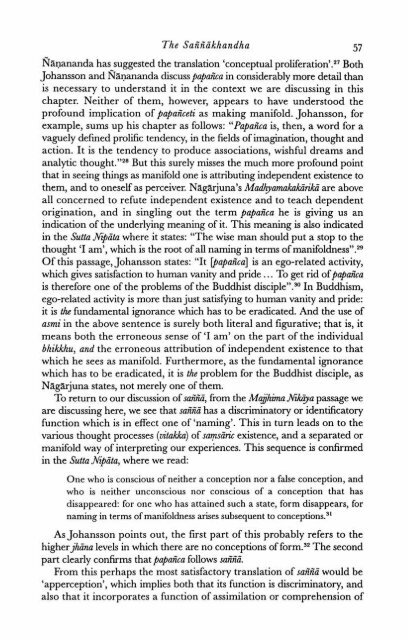Identity and Experience_Hamilton_1996
Identity and Experience_Hamilton_1996
Identity and Experience_Hamilton_1996
You also want an ePaper? Increase the reach of your titles
YUMPU automatically turns print PDFs into web optimized ePapers that Google loves.
The Saiiiiiikh<strong>and</strong>ha<br />
Ranan<strong>and</strong>a has suggested the translation 'conceptual proliferati~n'.~~ Both<br />
Johansson <strong>and</strong> Ranan<strong>and</strong>a discuss papaiica in considerably more detail than<br />
is necessary to underst<strong>and</strong> it in the context we are discussing in this<br />
chapter. Neither of them, however, appears to have understood the<br />
profound implication of papaiiceti as making manifold. Johansson, for<br />
example, sums up his chapter as follows: "Papan"ca is, then, a word for a<br />
vaguely defined prolific tendency, in the fields of imagination, thought <strong>and</strong><br />
action. It is the tendency to produce associations, wishful dreams <strong>and</strong><br />
analytic<br />
But this surely misses the much more profound point<br />
that in seeing things as manifold one is attributing independent existence to<br />
them, <strong>and</strong> to oneself as perceiver. Nagarjuna's Madhyamakaka-h- are above<br />
all concerned to refute independent existence <strong>and</strong> to teach dependent<br />
origination, <strong>and</strong> in singling out the term papaiica he is giving us an<br />
indication of the underlying meaning of it. This meaning is also indicated<br />
in the Suttu Nipita where it states: "The wise man should put a stop to the<br />
thought 'I am', which is the root of all naming in terms of manifoldne~s",~~<br />
Of this passage, Johansson states: "It @apaiica] is an ego-related activity,<br />
which gives satisfaction to human vanity <strong>and</strong> pride . . . To get rid ofpapaiica<br />
is therefore one of the problems of the Buddhist disciple".30 In Buddhism,<br />
ego-related activity is more than just satisfying to human vanity <strong>and</strong> pride:<br />
it is h fundamental ignorance which has to be eradicated. And the use of<br />
asmi in the above sentence is surely both literal <strong>and</strong> figurative; that is, it<br />
means both the erroneous sense of 'I am' on the part of the individual<br />
bhikkhu, <strong>and</strong> the erroneous attribution of independent existence to that<br />
which he sees as manifold. Furthermore, as the fundamental ignorance<br />
which has to be eradicated, it is the problem for the Buddhist disciple, as<br />
Nag-juna states, not merely one of them.<br />
To return to our discussion of saEiii, from the Majhima .iVihya passage we<br />
are discussing here, we see that saEEi has a discriminatory or identificatory<br />
function which is in effect one of 'naming'. This in turn leads on to the<br />
various thought processes (VitaWca) of sa;?zsiiric existence, <strong>and</strong> a separated or<br />
manifold way of interpreting our experiences. This sequence is confirmed<br />
in the Sutta NiZta, where we read:<br />
One who is conscious of neither a conception nor a false conception, <strong>and</strong><br />
who is neither unconscious nor conscious of a conception that has<br />
disappeared: for one who has attained such a state, form disappears, for<br />
naming in terms of manifoldness arises subsequent to conception^.^'<br />
As Johansson points out, the first part of this probably refers to the<br />
higherjhina levels in which there are no conceptions of form.32 The second<br />
part clearly confirms that papafica follows safin"Z.<br />
From this perhaps the most satisfactory translation of saEiii would be<br />
'apperception', which implies both that its function is discriminatory, <strong>and</strong><br />
also that it incorporates a function of assimilation or comprehension of


